Exploring the cosmos is a timeless pursuit, offering breathtaking views of distant planets, swirling nebulas, and glittering galaxies. Whether you’re captivated by the upcoming Flower Moon, the vibrant hues of stars like blue-white Vega or reddish Antares, or the subtle dance of Saturn near the crescent moon, having the right telescope can transform your view from the ordinary to the extraordinary. Choosing your first or next telescope can feel daunting, especially with a wide array of options available.
This guide helps you navigate the selection process, presenting some of the best amateur telescopes on the market, explaining key concepts, and ensuring you find the perfect instrument to begin or continue your journey through the night sky. We’ll delve into the specifics, helping you understand why these models stand out as top contenders among the top 10 amateur telescopes available for aspiring astronomers.
Finding the ideal telescope involves considering various factors like your budget, experience level, portability needs, and the types of celestial objects you wish to observe. Telescopes come in different designs – refractors, reflectors, and catadioptrics – each with its own strengths. Key specifications like aperture (light-gathering ability), focal length (magnification potential), and mount type (stability and tracking) significantly impact performance. Our recommendations are based on hands-on testing, evaluating observational capabilities, ease of use, and overall value. By understanding these elements, you can make an informed decision and unlock stunning views of the universe. For a deeper dive into telescope terminology, refer to our section on understanding telescope basics.
The Best Amateur Telescopes for Stargazers
Here are some of the most highly-rated telescopes suitable for amateur astronomers, covering a range of budgets, features, and designs.
Celestron NexStar 4SE
Best for Beginners
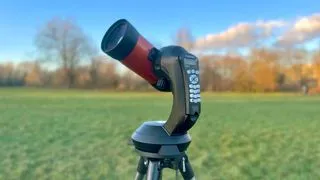
Man observing the night sky with a Celestron NexStar 4SE amateur telescope set up outdoors
A perfect starting point for newcomers, the Celestron NexStar 4SE makes stargazing accessible and rewarding. Its computerized GoTo mount simplifies finding celestial objects, allowing you to spend more time observing and less time searching. Our expert review highlighted its quick setup and user-friendly operation, ideal for those new to the hobby.
Discover the Best Overnight Summer Camps in Texas
Your Ultimate Guide to Oktoberfest Los Angeles 2024
Discover the Best Things to See in Sarasota
Specifications
Optical design: Maksutov-Cassegrain
Mount type: Computerized Alt-Azimuth
Aperture: 4-inches / 102mm
Focal length: 1325mm
Highest useful magnification: 241x
Lowest useful magnification: 15x
Supplied eyepieces: 25mm
Weight: 23 lbs (10.44kg) fully assembled
Reasons to buy
- Uncomplicated, quick setup
- Auto finds night sky objects
- High quality, sturdy build
- No collimation required
Reasons to avoid
- Narrow field of view
- Not very portable
- Limited accessories supplied
Buy it if
✅ It’s your first telescope: This scope is easy to use and set up, making it perfect for beginner astronomers.
✅ You want GoTo technology: You can easily find and track specific celestial objects with little or no prior knowledge.
Don’t buy it if:
❌ You want to travel with it: This telescope isn’t the most portable as the tripod doesn’t fold down entirely.
The bottom line: If you want to view the planets and bright objects in the sky quickly and effortlessly, the Celestron NexStar 4SE will certainly do the job.
- [external_link to Celestron NexStar 4SE review]
Celestron Inspire 100AZ Refractor
Best Budget Amateur Telescope
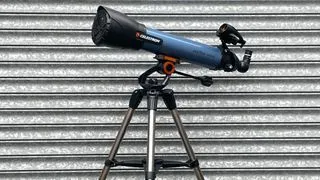 Side profile view of a Celestron Inspire 100AZ refractor telescope on a tripod
Side profile view of a Celestron Inspire 100AZ refractor telescope on a tripod
For budget-conscious astronomers, the Celestron Inspire 100AZ offers great value. This refractor telescope provides sharp views of the moon and planets and includes helpful accessories like a smartphone adaptor for easy astrophotography. It’s a fantastic entry-level instrument that balances performance with affordability.
Specifications
Optical design: Refractor
Mount type: Alt-azimuth
Aperture: 3.94-inches / 100mm
Focal length: 660mm
Highest useful magnification: 241x
Lowest useful magnification: 15x
Supplied eyepieces: 10mm, 25mm
Weight: 20 lbs (9.07kg)
Reasons to buy
- Sharp views of planets and the moon
- Handy smartphone adaptor
- Built-in red light
- Lightweight frame
Reasons to avoid
- Bearings lack precision
- Some chromatic aberration
- No solar observing possible
Buy it if
✅ You’re a beginner: We found it easy to set up and take down, perfect for beginners.
✅ You want to take astro shots on your smartphone: The lens cap cleverly turns into a smartphone holder so you can capture images of the night sky.
Don’t buy it if:
❌ You aren’t confident locating objects yourself: This telescope doesn’t have GoTo technology, so you’ll need to be able to locate specific celestial objects yourself (or with the help of a stargazing app).
❌ You want detailed views of deep sky objects: While this telescope can give great views of planets and the moon, objects further away may appear a little underwhelming.
The bottom line: Aimed at beginners and those looking to upgrade, this 4-inch refractor performs best with the moon and planets. It comes with a lens cap that converts to a smartphone holder for easy astrophotography.
- [external_link to Celestron Inspire 100AZ Refractor review]
Celestron Astro Fi 130
Best Value for Enthusiasts
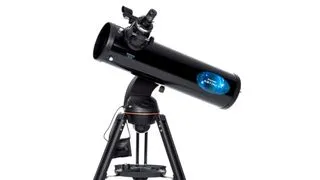 The Celestron Astro Fi 130 amateur telescope on a single fork arm alt-azimuth mount
The Celestron Astro Fi 130 amateur telescope on a single fork arm alt-azimuth mount
Offering a great balance of features and price, the Celestron Astro Fi 130 is excellent value for enthusiasts. This Newtonian reflector features a computerized mount controllable via a smartphone app, making navigation simple. It provides good views for an entry-level scope in its price range.
Specifications
Optical design: Newtonian Reflector
Mount type: Computerized altitude-azimuth single fork
Aperture: 5.19-inches / 130mm
Focal length: 650mm
Highest useful magnification: 307x
Lowest useful magnification: 19x
Supplied eyepieces: 25mm and 10mm
Weight: 18 lbs (8.6kg)
Reasons to buy
- Suitable for low budgets
- Great entry-level telescope
- Vixen dovetail for mount changes
- Portable
- Computer recommends targets
- Finds targets at touch of button
Reasons to avoid
- Eyepieces limit observations
- Focuser of low quality
- Battery drains quickly
- Useless without app
Buy it if
✅ You want a beginner-friendly, grab & go, easy-to-use telescope: We thought this was a great entry-level telescope that can find targets at the touch of a button and is great for on-the-go observations.
Don’t buy it if:
❌ You want a ‘traditional’ telescope: We found this telescope is completely useless without the app, so if you want a more traditional telescope without much of the newer technology, look elsewhere.
The bottom line: A good telescope at an exceptionally good price, it has everything you’d need if you’re just starting out, although we would recommend upgrading some of the pieces included. It can lose charge quickly in cold conditions, though, so consider buying an additional power source.
- [external_link to Celestron Astro Fi 130 review]
Celestron NexStar Evolution 9.25
Best Premium Amateur Telescope
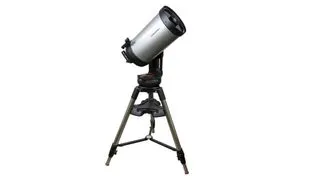 The Celestron NexStar Evolution 9.25 amateur telescope on a tripod
The Celestron NexStar Evolution 9.25 amateur telescope on a tripod
For serious amateur astronomers, the Celestron NexStar Evolution 9.25 represents a premium investment. This Schmidt-Cassegrain telescope delivers exceptionally crisp and detailed views, perfect for observing a wide range of celestial objects. Its robust, motorized mount and long battery life make it ideal for extended observation sessions or astrophotography.
Specifications
Optical design: Schmidt-Cassegrain
Mount type: Computerized alt-azimuth fork arm
Aperture: 9.25-inches / 235mm
Focal length: 2350mm
Highest useful magnification: 555x
Lowest useful magnification: 34x
Supplied eyepieces: 13mm, 40mm
Weight: 62.60 lbs (28.39kg)
Reasons to buy
- Crisp views with no defects
- Easy to set up
- High-quality design
Reasons to avoid
- Isn’t very portable — best for backyard star gazing
- Expensive
Buy it if
✅ You want to view a wide range of subjects: This scope has a large aperture which enables clear and detailed views of a wide range of celestial objects, including planets, deep-sky objects and nebulas.
✅ You’re an experienced skywatcher: Although its easy setup is a dream for beginners, this scope is best suited for more advanced, passionate astronomers who want a full view of the universe.
Don’t buy it if:
❌ You want something portable: Portability isn’t one of the Evolution 9.25’s strengths, so it’s best used for backyard gazing.
The bottom line: A fantastic telescope best suited to experienced skywatchers, with a price tag to match its premium features. It’s not the easiest to transport, but we think it’s one of the best GoTo telescopes you can buy.
Celestron Origin Intelligent Home Observatory
Best for Astrophotography
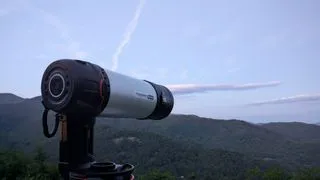 Celestron Origin Intelligent Home Observatory smart amateur telescope set up in a field
Celestron Origin Intelligent Home Observatory smart amateur telescope set up in a field
Stepping into smart technology, the Celestron Origin is designed specifically for astrophotography. This innovative telescope uses a built-in camera to capture and stack images, producing stunning deep sky photos in seconds, even from light-polluted areas. While lacking an eyepiece, its automated features are a boon for image enthusiasts.
Specifications
Optical design: Rowe-Ackermann Schmidt Astrograph (RASA)
Mount type: Motorized Alt-azimuth
Aperture: 6-inches / 152mm
Focal length: 335mm
Highest useful magnification: N/A
Lowest useful magnification: N/A
Supplied eyepieces: N/A
Weight: 41.6 lbs (18.6 kg)
Reasons to buy
- Crystal clear deep sky photos in seconds
- Quick set up
- Easy-to-use, helpful app
- Stacks and processes images automatically
Reasons to avoid
- Not ideal for all celestial objects
- Quite large and heavy
Buy it if
✅ You want an automated telescope: Focusing, tracking, finding targets and stacking processed images is all automatic with this one.
✅ You want to take deep sky images: The Origin can do this and more in just a few minutes, with little pre-knowledge required.
Don’t buy it if:
❌ You want a traditional telescope: This one doesn’t have an eyepiece and only gives you views of the night sky on a mobile device.
❌ You’re on a budget: At around $4,000, this telescope is on the pricier side.
The bottom line: This (pricey) smart telescope can do every part of stargazing autonomously, and produces beautiful photos of the night sky in seconds.
- [external_link to Celestron Origin Intelligent Home Observatory Smart Telescope review]
Celestron NexStar 8SE
Best Motorized Amateur Telescope
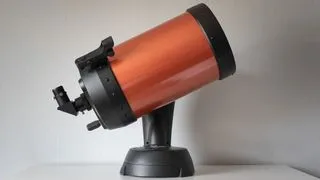 Celestron NexStar 8SE motorized amateur telescope with hand controller
Celestron NexStar 8SE motorized amateur telescope with hand controller
Affectionately known as ‘The World’s Most Beloved Telescope’, the Celestron NexStar 8SE combines powerful optics with a user-friendly motorized mount. Suitable for all skill levels, it offers incredibly bright and sharp views of planets and deep-sky objects. Its GoTo system makes navigating the night sky effortless.
Specifications
Optical design: Schmidt-Cassegrain
Mount type: Computerized alt-azimuth fork arm
Aperture: 8-inches / 203mm
Focal length: 2032mm
Highest useful magnification: 480x
Lowest useful magnification: 29x
Supplied eyepieces: 25mm
Weight: 32 lbs (14.48kg)
Reasons to buy
- Incredibly bright views
- Sharpness across the entire field of view
- Pricey, but good value for money
Reasons to avoid
- Will price some beginners out
- Slewing using the remote is a little laggy, but not much
Buy it if
✅ You’re looking for a long-term telescope: There’s no question that this telescope is pricey, but it’s one that will last you for decades — it’s not called ‘The World’s Most Beloved Telescope’ for nothing.
✅ You want to use it for astrophotography: Thanks to the smooth and accurate tracking, this scope is a great option for taking stunning astro images of deep sky objects.
Don’t buy it if:
❌ You’re on a budget: Although this is definitely worth the money and we’d recommend it if your budget can stretch to it, it is very pricey. If you’re on a budget or you’re new to the medium, there are plenty of cheaper alternatives that will be more than good enough.
The bottom line: An outstanding telescope with incredible optics that would suit a beginner, intermediate or advanced astronomer. It’s great for astrophotography and gives beautifully bright and detailed views. Our only fault with it is that it can price out beginners.
- [external_link to Celestron NexStar 8SE review]
Celestron Astro Fi 102
Best for Portability
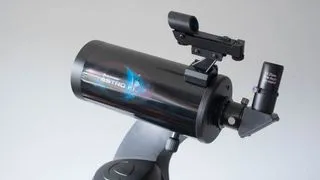 Compact Celestron Astro Fi 102 amateur telescope on a tripod
Compact Celestron Astro Fi 102 amateur telescope on a tripod
If you need a telescope that’s easy to transport, the Celestron Astro Fi 102 is an excellent candidate. Its lightweight and compact design make it perfect for travel to darker sky locations. While the build isn’t as premium as some higher-end models, its performance for viewing the moon and planets is impressive for its price point and portability.
Specifications
Optical design: Maksutov-Cassegrain
Mount type: Computerized Alt-Azimuth Single Fork Arm
Aperture: 4.0-inches / 102mm
Focal length: 1325mm
Highest useful magnification: Up to 100x with digital zoom
Lowest useful magnification: 15x
Supplied eyepieces: 25mm and 10mm
Weight: 6 lbs (2.7kg)
Reasons to buy
- Very portable thanks to its lightweight design
- Reasonably and fairly priced
- No prior experience needed
Reasons to avoid
- Optics could be better
- Tripod isn’t the best quality
- Doesn’t feel like a premium product to the touch
Buy it if
✅ You’ll be traveling with it: This scope is our top choice for portability, so it’s ideal if you plan on taking it away on camping trips or to areas with darker skies.
✅ You’re a beginner: If you just want to look at the moon and some planets, this is a great choice.
Don’t buy it if:
❌ You want good quality parts: This telescope has an element of ‘you get what you pay for’. It’s adequate for basic astronomy, but the tripod isn’t the best quality, the optics could be better and it didn’t have a premium feel.
The bottom line: Best suited for viewing the moon and planets, this telescope is great for beginners and anyone with no prior experience. It can be a little tricky to setup initially, and it’s not the best quality scope we’ve reviewed, but it’ll do the job.
- [external_link to Celestron Astro Fi 102 telescope review]
Sky-Watcher Skymax 150 PRO
Best for Accessories
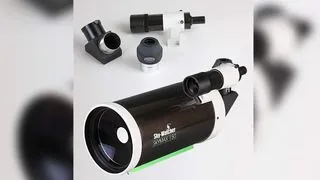 Sky-Watcher Skymax 150 PRO amateur telescope and included accessories
Sky-Watcher Skymax 150 PRO amateur telescope and included accessories
Tailored for astrophotographers who love to customize their setup, the Sky-Watcher Skymax 150 PRO excels in its ability to accommodate a wide range of accessories, including cameras and filter wheels. Its high-quality Maksutov-Cassegrain optics deliver crisp, distortion-free views, making it versatile for capturing both planetary and deep-sky subjects.
Specifications
Optical design: Maksutov-Cassegrain
Mount type: Equatorial (EQ-5 Pro)
Aperture: 5.90-inches / 150mm
Focal length: 1800mm
Highest useful magnification: 450x
Lowest useful magnification: 36x
Supplied eyepieces: 28 mm
Weight: 13.23 lbs (6kg)
Reasons to buy
- High-quality, lightweight build
- Excellent optics
- Great for a wide selection of astrophotography
Reasons to avoid
- Not all models come with a tripod
- Comes with only one eyepiece
Buy it if
✅ You want to travel with it: Most astrophotography involves traveling to dark sky sites, and this telescope is light enough to do just that.
✅ Your primary focus is astrophotography: We recommend this telescope as the best for astrophotography thanks to its amazing optics.
Don’t buy it if:
❌ You’re looking for something super sophisticated: For those looking for high-end, sophisticated instruments and have the money to spend on them, a smart telescope would likely be a better fit.
The bottom line: This telescope is perfect for astrophotographers who want to take it on shoots — it has great quality optics and an excellent build. It can accommodate plenty of accessories, although not all models come with a tripod.
- [external_link to Sky-Watcher Skymax 150 PRO product page]
Unistellar eQuinox 2 Smart Telescope
Best Smart Amateur Telescope
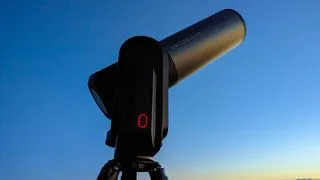 Unistellar eQuinox 2 smart amateur telescope set up at night
Unistellar eQuinox 2 smart amateur telescope set up at night
A leap into the future of amateur astronomy, the Unistellar eQuinox 2 is a high-tech smart telescope controlled entirely via a smartphone app. It excels in urban environments thanks to its Smart Light Pollution Reduction feature, allowing users to view and share stunning images of celestial objects in real-time without needing an eyepiece.
Specifications
Optical design: Newtonian Reflector
Mount type: Motorized GoTo alt-azimuth
Aperture: 4.49-inches / 114mm
Focal length: 450mm
Highest useful magnification: 400x digital
Lowest useful magnification: 50x optical
Supplied eyepieces: N/A
Weight: 19.8 lbs (9kg)
Reasons to buy
- Beautiful, simple layout and design
- Get views of the night sky fast
- App is easy to operate
Reasons to avoid
- Image resolution is average
- Can’t orientate telescope in twilight
- Laggy views when focusing
Buy it if
✅ You live in an urban area: This scope has a Smart Light Pollution Reduction feature that removes light pollution, so it’s a great option if you don’t live near a dark sky site.
✅ You want simplicity: This is an incredibly sleek, all-in-one telescope that has no need for additional accessories and can take you to your chosen celestial objects with ease.
Don’t buy it if:
❌ You’re on a budget: Unsurprisingly, this is an expensive bit of kit, so it’ll price out most beginners and anyone who doesn’t have a big budget.
The bottom line: An easy-to-use motorized smart telescope that can locate night sky objects at the push of a button, the eQuinox 2 can have you exploring the stars in minutes without the need for prior knowledge, although its in-built camera isn’t quite detailed enough.
- [external_link to Unistellar eQuinox 2 telescope review]
Celestron Advanced VX 8 EdgeHD
Best for Deep Space Observation
 Celestron Advanced VX 8 EdgeHD Schmidt-Cassegrain amateur telescope setup
Celestron Advanced VX 8 EdgeHD Schmidt-Cassegrain amateur telescope setup
Designed for serious amateurs, the Celestron Advanced VX 8 EdgeHD boasts advanced optics specifically engineered for astrophotography and detailed deep space viewing. Its EdgeHD technology provides pinpoint sharpness across the entire field of view, making it an excellent choice for capturing stunning images of distant galaxies and nebulas.
Specifications
Optical design: Schmidt-Cassegrain
Mount type: Motorized equatorial
Aperture: 8-inches / 203.2mm
Focal length: 2032mm
Highest useful magnification: 480x
Lowest useful magnification: 29x
Supplied eyepieces: 40mm
Weight: 61 lbs (27.67kg)
Reasons to buy
- EdgeHD has the best optics available in a telescope of this size
- Computerized mount finds and tracks objects reliably
- Dovetail mount system
- Proven design on the market for years, incrementally refined
Reasons to avoid
- Setting up requires some knowledge of the sky
- Only one eyepiece is supplied
- Needs a sturdier mount for serious long-exposure photography
Buy it if
✅ You want to see everything: While some telescopes are only good for seeing the moon and planets or deep space, this telescope is good for seeing all types of celestial objects.
✅ You want a seamless experience: We found the motorized mount on this telescope very smooth and slick.
Don’t buy it if:
❌ You’re a beginner: This telescope is intended for those with experience and knowledge of the sky and telescopes, so if you’re just starting out, we’d suggest a more beginner-friendly model.
❌ You want something lightweight: At 61 lbs (27.67kg), this telescope is heavier than most other choices in this guide.
The bottom line: Intended for serious amateurs, this optically excellent telescope is suitable for all types of visual astronomy with its rugged, lightweight computerized mount. If you know the sky and plan to be doing astronomy for a long time, this is the telescope to get.
- [external_link to Celestron Advanced VX 8 EdgeHD telescope review]
Celestron FirstScope 76 Tabletop telescope
Best for Kids
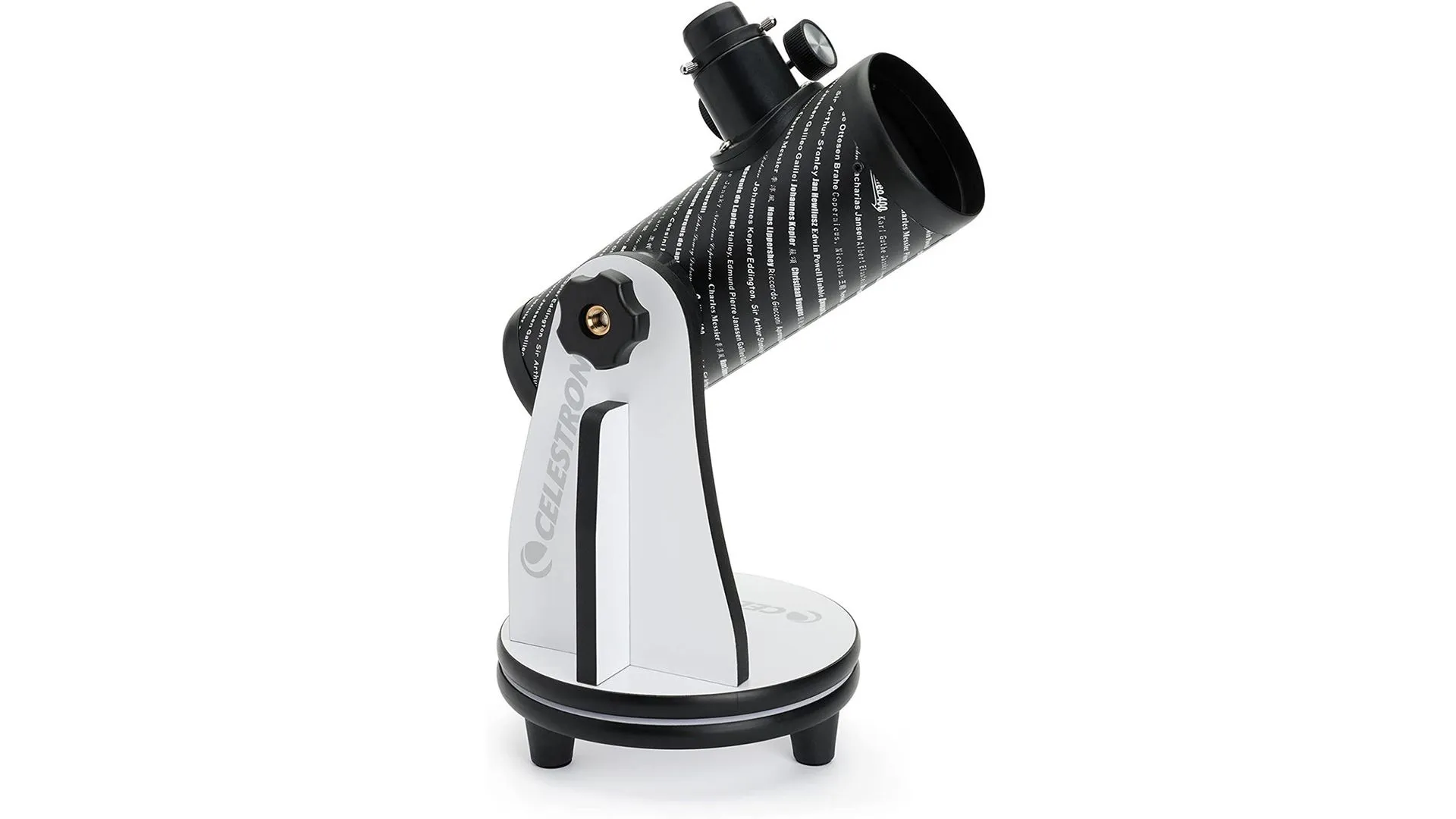 Celestron FirstScope 76 tabletop amateur telescope
Celestron FirstScope 76 tabletop amateur telescope
Introducing young astronomers to the wonders of the night sky is easy with the Celestron FirstScope 76. This affordable tabletop telescope is lightweight, portable, and requires no complex setup, arriving ready to use straight out of the box. While not the most powerful, its ease of use and robust build make it an excellent low-investment option for casual observation.
Specifications
Optical design: Reflector
Mount type: Dobsonian
Aperture: 2.99-inch / 76mm
Focal length: 11.81-inch / 300mm
Highest useful magnification: 180x
Lowest useful magnification: 11x
Supplied eyepieces: 4mm, 20mm
Weight: 4.5 lbs / 2.04kg
Reasons to buy
- Portable
- Easy to use
- Robust build
- Low investment for casual or young astronomers
- Fast focal ratio for easy observations of wide-angle targets
Reasons to avoid
- Loose focuser
- Some observations lack clarity and detail
- A challenge to collimate
- Finderscope not supplied
Buy it if
✅ You want low investment: For casual viewing, this telescope is a great option with a low price point.
✅ You don’t want to spend ages setting it up: It arrives assembled and ready to go, so no complicated setup process needed.
Don’t buy it if:
❌ You want to find objects easily: It doesn’t come with a finderscope, so anyone wanting to locate certain celestial objects easily may get frustrated.
❌ You want all the extras: This package doesn’t include a finderscope, so you’ll need to either buy one separately or consider another telescope package that does.
The bottom line: If you have children who have been bugging you for a telescope and you can’t quite commit to a moderately-priced instrument, then the FirstScope may be for you — especially if the moon and casual glances at the night sky are of interest.
- [external_link to Celestron FirstScope 76 Tabletop telescope review]
Understanding Telescope Types and Terminology
To make the best choice from the top 10 amateur telescopes (and beyond!), it helps to understand the basics of how telescopes work and the terms used to describe them.
How Does a Refractor Telescope Work?
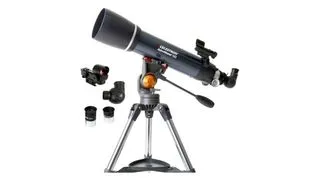 Celestron AstroMaster 102AZ refractor amateur telescope and accessories
Celestron AstroMaster 102AZ refractor amateur telescope and accessories
Refractor telescopes use lenses to bend light, focusing it into an image that is then magnified by the eyepiece. They are typically low-maintenance and easy to set up, making them popular for beginners. Refractors are excellent for viewing the moon and planets, offering high-contrast images. However, larger apertures become expensive, and they can sometimes suffer from chromatic aberration (color fringing).
How Does a Reflector Telescope Work?
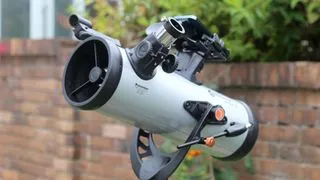 Celestron StarSense Explorer LT 114AZ reflector amateur telescope pointing at the sky
Celestron StarSense Explorer LT 114AZ reflector amateur telescope pointing at the sky
Reflector telescopes, like the common Newtonian design, use mirrors to collect and focus light. A primary mirror at the base of the tube reflects light to a smaller secondary mirror near the front, which directs the image to the eyepiece. Reflectors offer more aperture for your money compared to refractors and are great for observing fainter deep-sky objects like galaxies and nebulas. They require periodic mirror alignment (collimation) and the mirrors may need occasional cleaning or recoating.
How Does a Catadioptric Telescope Work?
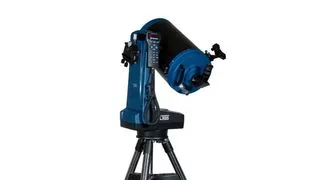 Meade Instruments LX65 GoTo catadioptric amateur telescope
Meade Instruments LX65 GoTo catadioptric amateur telescope
Catadioptric telescopes combine both lenses and mirrors to create a compact design that offers high magnification. Types like the Schmidt-Cassegrain and Maksutov-Cassegrain use a correcting lens at the front and mirrors internally. This design results in a shorter tube for their focal length, making them more portable. They are versatile for both planetary and deep-sky observation and are often favored for astrophotography due to their flat field of view (especially with EdgeHD technology). However, they tend to be more expensive than refractors or reflectors of comparable aperture.
What is a Finderscope?
 Red dot finderscope attached to a Celestron Starsense explorer 8-inch dobsonian amateur telescope
Red dot finderscope attached to a Celestron Starsense explorer 8-inch dobsonian amateur telescope
A finderscope is a small, low-magnification aiming device mounted parallel to your main telescope tube. Because the main telescope has a narrow field of view, it can be difficult to locate objects. The finderscope, with its much wider field of view, helps you pinpoint your target in the sky before centering it in the main telescope’s eyepiece. They often have crosshairs or a red dot to aid in alignment.
What Does Aperture, Magnification and Focal Length Mean?
- Aperture: This is the diameter of the main light-gathering component – either the objective lens (refractor) or the primary mirror (reflector/catadioptric). A larger aperture collects more light, allowing you to see fainter objects and finer details.
- Focal Length: The distance from the lens or mirror to the point where light converges to form an image. A longer focal length generally results in higher potential magnification but a narrower field of view.
- Magnification: How much larger an object appears through the telescope. It is calculated by dividing the telescope’s focal length by the focal length of the eyepiece being used. While high magnification is exciting, it also dims the image and magnifies atmospheric turbulence. Useful magnification is limited by the telescope’s aperture and observing conditions.
Magnification: How Do Telescope Eyepieces Work?
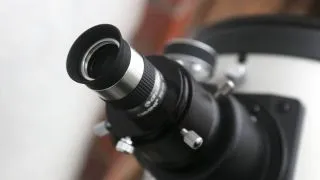 Close-up view of an eyepiece from a Celestron Starsense explorer 8-inch dobsonian amateur telescope
Close-up view of an eyepiece from a Celestron Starsense explorer 8-inch dobsonian amateur telescope
Telescope eyepieces are like interchangeable lenses for your telescope. Each eyepiece has its own focal length (marked in millimeters). The shorter the eyepiece’s focal length, the higher the magnification it provides when used with a specific telescope. Having a selection of eyepieces with different focal lengths allows you to vary the magnification, choosing the best power for the object you’re observing and the viewing conditions. Aim for low, medium, and high power eyepieces for versatility.
How We Test the Top 10 Amateur Telescopes
To provide reliable recommendations for the top 10 amateur telescopes (and others we review), our experts conduct thorough hands-on testing. We evaluate each telescope based on its performance in real-world observation sessions.
Testing includes:
- Build Quality: Assessing the sturdiness and durability of the optical tube, mount, and tripod.
- Ease of Setup and Use: How quickly and simply the telescope can be assembled, aligned, and operated, particularly for beginners.
- Optical Performance: Observing various celestial objects (Moon, planets, stars, nebulas, galaxies) to evaluate image clarity, brightness, contrast, and sharpness across the field of view. We look for aberrations like chromatic aberration or coma.
- Mount Functionality: Testing the stability, smoothness, and tracking accuracy of the mount, especially for motorized or GoTo systems.
- Accessories: Assessing the quality and usefulness of included eyepieces, finderscopes, and other accessories.
- Portability: Evaluating how easy the telescope is to transport for observing from different locations.
- Features: Testing specific features like GoTo systems, smartphone integration, and astrophotography capabilities.
Our experienced reviewers, including seasoned stargazers and astronomy experts, compare manufacturer claims against actual performance to ensure our recommendations are accurate and helpful for anyone looking to buy a telescope.
